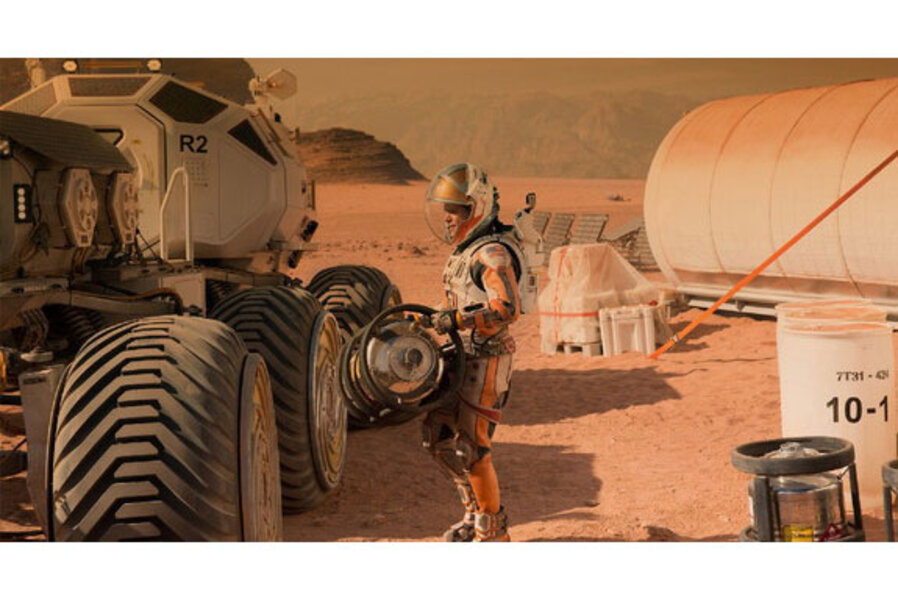What's the story with Matt Damon's spacesuit in 'The Martian'?
The upcoming sci-fi film "The Martian" features many real-life technologies being developed to help put boots on the Red Planet, but the sleek spacesuits showcased in the movie were pretty much invented out of whole cloth.
Janty Yates, the costume designer for "The Martian," originally looked for inspiration to NASA's prototype Z1 and Z2 spacesuits. She worked with NASA officials and engineers, whom she described as "bend-over-backwards helpful." But in the end, she and her team came up with something new for the main spacesuit in "The Martian," which hits theaters Friday (Oct. 2) across the United States.
"We basically had to start from scratch," Yates told Space.com. "We would've loved to use NASA's designs, but in the end, we just couldn't do it." ["The Martian": An Epic Space Film in Photos]
A new Mars spacesuit
"The Martian" stars Matt Damon as NASA astronaut Mark Watney, who is stranded alone on Mars and presumed dead. Watney must use his ingenuity and engineering smarts to survive and let NASA know he's alive, so the agency can mount a rescue mission.
"The Martian" director Ridley Scott needed great visuals of Watney's face (as well as the faces of his crewmates) from a variety of angles, and the Z1 and Z2 — which both feature helmets that meld into the shoulder region of the suit — could not meet that requirement, Yates said.
"Ridley needed to see his actors in profile; he needed to see them moving their heads; he needed close-ups on the eyes," said Yates, who has worked with Scott repeatedly over the years. (She won an Oscar for her work on Scott's 2000 film "Gladiator.")
Aesthetics were also an issue; Scott didn't find the Z-2 spacesuit visually striking enough, Yates said.
Yates worked with concept artists to draw up a variety of basic designs for the suit worn by Watney and his crewmates on the Martian surface, then presented them to Scott for approval. The body-hugging, black-white-and-orange suit showcased in the film emerged by process of elimination. (Interestingly, the movie's suit superficially resembles the Biosuit, a real space garment being developed by researchers at the Massachusetts Institute of Technology.)
The costume-design team built the surface suit out of neoprene, the same material wetsuits are made of. The suits weigh a maximum of 15 to 20 lbs. (6.8 to 9.1 kilograms), though the actors wore heavy belts as well, Yates said.
Damon and the other actors wore "cooling suits" beneath their spacesuits — basically, shirts and pants outfitted with tubes through which cold water can be pumped. Such cooling measures were doubtless appreciated, because the cast often wore their spacesuits for 10 to 12 hours per day during shooting, Yates said.
The helmet was the most technically advanced part of the suit; it contained systems that pumped air in for the actors to breathe and also featured lighting and communications gear. But the movie suit's helmets were nowhere near as sophisticated as the equipment that real astronauts use, Yates said.
"The helmet was only technical to the point that we needed it to function," she said. "Keeping people alive is the most technical aspect of our work."
Working with NASA
NASA officials and researchers served as advisers on "The Martian," which is based on the novel of the same name by Andy Weir. And the space agency has been helping to promote the film, as a way to get the word out about its own plans to send astronauts to Mars in the 2030s.
So, while NASA didn't come up with the surface suit featured in "The Martian," agency officials did approve the astronaut apparel.
"As we went along, we had to submit the designs for their approval," Yates said. "And they approved along the way, as did the [film's] art department."
"The Martian" features one other spacesuit in addition to the surface suit — a bulky white extravehicular activity (EVA) suit the astronauts wear in space. The film's EVA suit is modeled closely on the one NASA astronauts wear on spacewalks outside the International Space Station, Yates said.
"We kept that very much to NASA style, but we made it a lot more streamlined," she said.
Yates said she's very grateful for the help and support NASA has provided, both during the making of the film and its promotion. The collaboration has been exciting for her personally as well.
"I was very lucky — I was able to go to JPL," Yates said, referring to the space agency's Jet Propulsion Laboratory in Pasadena, California. "That was probably the best day of my life."
Follow Mike Wall on Twitter @michaeldwall and Google+. Follow us @Spacedotcom, Facebook orGoogle+. Originally published on Space.com.
- How To Kill (Or Save) A Martian – Author Andy Weir Knows! | Video
- Matt Damon – Making 'The Martian' Was Amazing | Exclusive Interview
- Evolution of the Spacesuit in Pictures (Space Tech Gallery)
Copyright 2015 SPACE.com, a Purch company. All rights reserved. This material may not be published, broadcast, rewritten or redistributed.








